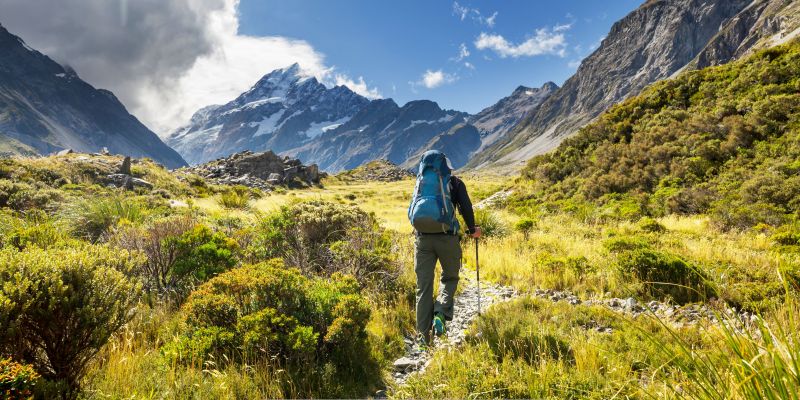Soft hiking is a gentle approach to exploring the great outdoors, designed to accommodate individuals of varying fitness levels and ages. Unlike traditional hiking, which often involves steep ascents and rugged terrains, soft hiking focuses on well-maintained trails that are accessible and easy to navigate. This form of hiking emphasizes the enjoyment of nature rather than the physical exertion typically associated with more challenging hikes.
Soft hiking trails can be found in parks, nature reserves, and scenic areas, making them ideal for families, beginners, or anyone looking to reconnect with nature without the strain of a strenuous trek. The essence of soft hiking lies in its inclusivity. It invites people who may feel intimidated by the idea of hiking to step outside and experience the beauty of their surroundings.
Soft hiking trails often feature gentle slopes, wide paths, and minimal obstacles, allowing participants to immerse themselves in nature at a leisurely pace. This approach not only fosters a sense of community among hikers but also encourages individuals to appreciate the small wonders of the natural world, such as the rustling of leaves or the chirping of birds.
Key Takeaways
- Soft hiking is a low-impact, leisurely form of hiking that focuses on enjoying nature and the outdoors at a relaxed pace.
- The benefits of soft hiking include improved mental and physical health, stress relief, and a deeper connection with nature.
- When choosing the right soft hiking trail, consider factors such as distance, terrain, and level of difficulty to ensure a safe and enjoyable experience.
- Essential gear for soft hiking includes comfortable footwear, weather-appropriate clothing, a backpack with water and snacks, and navigation tools such as a map or GPS.
- Tips for a safe and enjoyable soft hiking experience include staying hydrated, being mindful of wildlife, and leaving no trace by practicing Leave No Trace principles.
The Benefits of Soft Hiking
Engaging in soft hiking offers numerous benefits that extend beyond physical fitness. One of the most significant advantages is the opportunity for mental rejuvenation. The serene environment of soft hiking trails allows individuals to escape the hustle and bustle of daily life, providing a much-needed respite from stress.
As hikers meander through lush landscapes, they often find themselves feeling more relaxed and centered, which can lead to improved mental clarity and emotional well-being. In addition to mental health benefits, soft hiking promotes physical activity in a low-impact manner. It encourages individuals to move their bodies without the risk of injury that can accompany more strenuous hikes.
This makes it an excellent option for those recovering from injuries or those who may have mobility issues. Regular participation in soft hiking can enhance cardiovascular health, improve muscle tone, and boost overall stamina, all while enjoying the beauty of nature.
How to Choose the Right Soft Hiking Trail

Selecting the right soft hiking trail is crucial for ensuring an enjoyable experience. Hikers should consider their own fitness levels and preferences when choosing a trail. Many parks and outdoor recreation areas provide detailed information about their trails, including difficulty ratings, length, and terrain type.
Beginners may want to start with shorter trails that offer gentle inclines and well-marked paths, while more experienced hikers might seek out longer routes that still maintain a soft hiking profile. Another important factor to consider is the natural environment surrounding the trail. Some may prefer coastal paths with ocean views, while others might be drawn to forested areas filled with wildlife.
Researching local flora and fauna can enhance the experience, as hikers can look forward to spotting unique plants or animals along their journey. Additionally, checking weather conditions and trail accessibility is essential to ensure a safe and pleasant outing.
Essential Gear for Soft Hiking
| Item | Description |
|---|---|
| Hiking Boots | Durable, ankle-supporting boots with good traction |
| Backpack | Comfortable, lightweight pack with enough space for essentials |
| Water Bottle | Reusable, durable bottle for staying hydrated on the trail |
| Map & Compass | Navigation tools for staying on course |
| Sun Protection | Sunscreen, hat, and sunglasses to protect from UV rays |
| First Aid Kit | Basic supplies for treating minor injuries on the trail |
| Snacks | Energy-boosting snacks like trail mix or granola bars |
While soft hiking is generally less demanding than traditional hiking, having the right gear can significantly enhance the experience. Comfortable footwear is paramount; well-fitting hiking shoes or sturdy sneakers with good traction will help prevent slips and blisters on varied terrain. Breathable clothing that wicks moisture away from the body is also recommended, as it allows for comfort during warmer days or when traversing sunny paths.
In addition to footwear and clothing, carrying a small backpack with essentials can make a soft hiking adventure more enjoyable. Items such as water bottles, snacks, sunscreen, and a first-aid kit are vital for staying hydrated and energized throughout the hike. A lightweight camera or binoculars can also be beneficial for capturing memories or observing wildlife up close.
By being prepared with the right gear, hikers can focus on enjoying their surroundings rather than worrying about discomfort or unforeseen circumstances.
Tips for a Safe and Enjoyable Soft Hiking Experience
Safety should always be a priority when embarking on any outdoor adventure, including soft hiking. One of the most important tips is to inform someone about the planned route and expected return time. This ensures that someone is aware of their whereabouts in case of an emergency.
Additionally, hikers should familiarize themselves with basic navigation skills or carry a map and compass or GPS device to avoid getting lost. Another key aspect of safety is being aware of one’s surroundings. Hikers should pay attention to trail markers and signs while remaining vigilant for potential hazards such as uneven ground or wildlife encounters.
It’s also wise to hike with a buddy or group whenever possible; this not only enhances safety but also adds to the enjoyment of sharing experiences with others. By following these guidelines, hikers can ensure a safe and fulfilling soft hiking experience.
Exploring Nature on a Soft Hiking Adventure

Immersive Experience
Moreover, soft hiking encourages mindfulness and presence in the moment. The slower pace allows hikers to engage their senses fully—listening to the sounds of rustling leaves, feeling the texture of tree bark, and inhaling the fresh scent of pine or blooming flowers.
Connection with Nature
This immersive experience fosters a deeper connection with nature, reminding individuals of the importance of preserving these natural spaces for future generations.
Preserving Natural Spaces
By slowing down and appreciating the beauty of nature, soft hikers can develop a sense of responsibility to protect and preserve these ecosystems for years to come.
Soft Hiking for All Ages and Fitness Levels
One of the most appealing aspects of soft hiking is its accessibility for people of all ages and fitness levels. Families with young children can enjoy short trails that are safe and engaging, allowing kids to explore their surroundings while developing an appreciation for nature. Seniors or individuals with limited mobility can also partake in soft hiking by choosing flat paths that accommodate their needs.
Community programs often promote soft hiking as a way to encourage physical activity among diverse groups. Many parks offer guided hikes tailored to specific age groups or fitness levels, ensuring that everyone can participate comfortably. This inclusivity not only fosters a sense of belonging but also helps build friendships among participants who share a love for the outdoors.
Connecting with the Outdoors through Soft Hiking
Soft hiking serves as a bridge between individuals and the natural world, fostering a sense of connection that can be profoundly transformative. As hikers traverse scenic trails, they often find themselves reflecting on their place within the larger ecosystem. This connection can lead to increased environmental awareness and a desire to protect natural spaces.
Participating in soft hiking also allows individuals to engage with their local communities in meaningful ways. Many parks host events such as clean-up days or educational workshops that encourage hikers to give back to their environment. By actively participating in these initiatives, individuals not only enhance their own experiences but also contribute to preserving the beauty of nature for others to enjoy.
Soft Hiking as a Stress-Relieving Activity
In today’s fast-paced world, finding effective ways to manage stress is essential for maintaining overall well-being. Soft hiking offers a unique remedy by combining physical activity with the calming effects of nature. Studies have shown that spending time outdoors can lower cortisol levels—the hormone associated with stress—while promoting feelings of relaxation and happiness.
The rhythmic motion of walking combined with fresh air and natural surroundings creates an ideal environment for stress relief. Hikers often report feeling rejuvenated after spending time on soft trails, as they leave behind their worries and immerse themselves in the tranquility of nature. This restorative experience not only enhances mental health but also encourages individuals to prioritize self-care through regular outdoor activities.
Soft Hiking: A Sustainable and Eco-Friendly Activity
As awareness of environmental issues grows, many outdoor enthusiasts are seeking sustainable ways to enjoy nature without causing harm. Soft hiking aligns perfectly with this ethos by promoting eco-friendly practices that minimize impact on natural habitats. Choosing well-established trails helps preserve delicate ecosystems while reducing erosion caused by foot traffic.
Hikers can further contribute to sustainability by practicing Leave No Trace principles—such as packing out all trash, staying on designated paths, and respecting wildlife habitats. By adopting these practices, individuals can enjoy their soft hiking adventures while ensuring that future generations have access to pristine natural spaces. This commitment to sustainability enhances the overall experience by fostering a sense of responsibility toward protecting the environment.
Joining a Soft Hiking Community: Finding Like-Minded Outdoor Enthusiasts
For those looking to deepen their connection with soft hiking, joining a community can be an enriching experience. Many local organizations offer group hikes or events that cater specifically to soft hiking enthusiasts. These gatherings provide opportunities for individuals to meet like-minded people who share a passion for exploring nature at a leisurely pace.
Being part of a soft hiking community not only enhances social connections but also opens doors to new experiences and knowledge sharing. Participants can learn about local flora and fauna from experienced guides or discover hidden gems within their region’s natural landscape. This sense of camaraderie fosters lasting friendships while encouraging individuals to continue exploring the great outdoors together.
In conclusion, soft hiking presents an inviting way for people of all ages and fitness levels to engage with nature while reaping numerous physical and mental health benefits. By choosing appropriate trails, equipping themselves with essential gear, and prioritizing safety, individuals can embark on fulfilling outdoor adventures that promote well-being and environmental stewardship. Whether seeking solitude or community connection, soft hiking offers something for everyone—a chance to explore the beauty of nature at a gentle pace while fostering lasting memories along the way.
FAQs
What is soft hiking?
Soft hiking is a form of hiking that focuses on leisurely walking and enjoying nature, rather than intense physical exertion. It is often done on well-maintained trails and is suitable for people of all fitness levels.
What are the benefits of soft hiking?
Soft hiking allows individuals to enjoy the outdoors, get some light exercise, and reduce stress. It can also be a great way to socialize with friends and family while exploring natural landscapes.
What gear is needed for soft hiking?
For soft hiking, comfortable and supportive footwear is essential, as well as weather-appropriate clothing. It’s also a good idea to bring water, snacks, a map, and a first aid kit.
Where can I go soft hiking?
Soft hiking can be done in a variety of locations, including local parks, nature reserves, and designated hiking trails. Many areas have specific trails that are well-suited for soft hiking.
Is soft hiking suitable for beginners?
Yes, soft hiking is a great option for beginners who are looking to ease into hiking. The gentle terrain and relaxed pace make it accessible to people of all ages and fitness levels.









